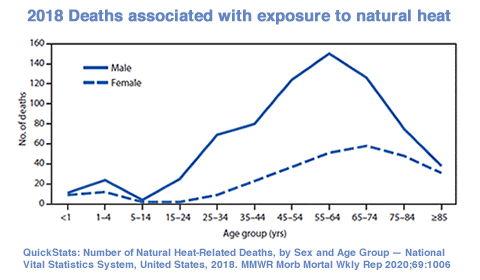Hyperthermia
risk factors in the elderly
 About 700 people die each year in the
United States from avoidable exposure to extreme heat. On average, 65,574 emergency room visits with an average of 8992 hospitalizations occur annually due to heat exposure. Individuals 65 years
of age or older suffer many of these heat related deaths.
About 700 people die each year in the
United States from avoidable exposure to extreme heat. On average, 65,574 emergency room visits with an average of 8992 hospitalizations occur annually due to heat exposure. Individuals 65 years
of age or older suffer many of these heat related deaths.
In 2018, natural heat exposure was associated with 726 deaths among males and 282 deaths among females. Among males, the highest number of heat-related deaths was within those aged 55–64 years (150) and among females within those aged 65–74 years (58). The lowest numbers were for males (four) and females (two) aged 5–14 years. Approximately 72% of heat-related deaths were among males.
It is important to note that the ambient temperature
does not have to reach 100 degrees for elders to be at risk of hyperthermia. External heat gain occurs
whenever a person is exposed to an environmental temperature which is greater than the individual's ability to dissipate. Elders often
have a decreased ability to dissipate heat. The National Institutes on Aging (2018) has published factors that increase the risk of hyperthermia in the elderly. Those factors include:
- Age-related changes to the skin such as poor blood circulation and inefficient sweat glands
- Heart, lung, and kidney diseases, as well as any illness that causes general weakness or fever
- High blood pressure or other conditions that require changes in diet, such as salt-restricted diets
- Reduced sweating, caused by medications such as diuretics, sedatives, tranquilizers, and certain heart and blood pressure drugs
- Taking several drugs for various conditions (It is important, however, to continue to take prescribed medication and discuss possible problems with a physician.)
- Being substantially overweight or underweight
- Drinking alcoholic beverages
- Being dehydrated
Lifestyle factors can also increase risk, including:
- extremely hot living quarters
- lack of transportation
- overdressing
- visiting overcrowded places
- not understanding how to respond to weather conditions.
Many commonly prescribed drugs
can increase heat retention or interfere with an elder's ability
to dissipate heat.
- Alcohol - alters awareness of heat
- Anticholingergics inhibit
sweating. They are commonly used to treat urinary dysfunction, peptic ulcer disease, irritable bowel syndrome or Parkinson’s disease.
- Antihistamines - inhibits
sweating
- Diuretics - hypovolemia, dehydration can increase heat storage by impairing sweating and reduced skin blood flow.
- Beta-blockers - impair
cutaneous blood flow by reducing cardiovascular response.
Instant
Feedback:
Hypovolemia and dehydration can increase the elderly person's risk of hyperthermia.
©RnCeus.com
 About 700 people die each year in the
United States from avoidable exposure to extreme heat. On average, 65,574 emergency room visits with an average of 8992 hospitalizations occur annually due to heat exposure. Individuals 65 years
of age or older suffer many of these heat related deaths.
About 700 people die each year in the
United States from avoidable exposure to extreme heat. On average, 65,574 emergency room visits with an average of 8992 hospitalizations occur annually due to heat exposure. Individuals 65 years
of age or older suffer many of these heat related deaths.